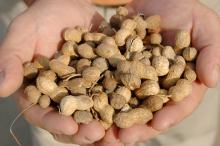Information Possibly Outdated
The information presented on this page was originally released on October 21, 2011. It may not be outdated, but please search our site for more current information. If you plan to quote or reference this information in a publication, please check with the Extension specialist or author before proceeding.
Mississippi peanut growers get highest yields in nation
MISSISSIPPI STATE – Timely rains in early September made a smooth harvest for Mississippi peanuts, a crop that is in high demand due to drought in other peanut-growing areas.
As of Oct. 1, the U.S. Department of Agriculture forecast 2011 crop yields at 3,600 pounds per acre for Mississippi, the highest prediction for any of the peanut-producing states. Harvest began in mid-September and was 70 percent complete by mid-October. Producers were working as fast as they could to get the crop out of the ground after cold temperatures ended peanut maturity.
Mike Howell, Mississippi State University Extension Service peanut specialist, said the high yield is good news for producers, because prices for peanuts have at least doubled in the past year. However, growers may not benefit until it is time to contract for next year’s crop.
“Most of the prices are $1,000 per ton, due strictly to supply and demand,” Howell said. “When cotton prices started going up last winter, the peanut prices didn’t move as fast, and nationally we lost a lot of acres to cotton.
“Peanuts are down 30 percent in acres planted nationwide. Mississippi is down about 25 percent. Also, we thought we had enough peanuts in storage for this year, but we ended up having quality issues with the 2010 crop, so there aren’t as many peanuts in the system,” he said.
Malcolm Broome, executive director of the Mississippi Peanut Growers Association, described the current situation as a perfect storm of factors that have driven up the price of peanuts to the point that manufacturers are raising the price of peanut butter by 20 to 30 percent.
“The problem resulted from a low carry-over of peanuts from last year coupled with a severe drought this year in many areas that grow peanuts,” he said. “Most growers in Mississippi contracted their peanuts at around $500 a ton before planting this season, so very little is left to sell at the current higher prices.
“Growers are not the cause of the higher peanut butter prices that manufacturers have announced. Even at a higher price, peanut butter is still a smart purchase for consumers based on its nutrient value,” Broome said.
Predicting future prices will have to wait until harvest is complete in Georgia, the nation’s largest peanut producer, Howell said.
“Georgia is currently picking their best-irrigated peanuts with good yields, but they have a lot of dryland peanuts left to go, so yield and quality issues are yet to be determined,” he said. “From all indications, we’re going to have a deficit going into next year.”
Higher prices are tough news for consumers, but could be a boon for growers as they plan for next year.
“We could be looking at pretty strong contract prices for producers,” Howell said. “The only thing I’m worried about is that input costs are going to go up because prices will be strong for all of our commodities. Seed prices were around 90 cents per pound this year but will likely go well over a dollar next year.”
Mississippi is relatively new to growing peanuts. The state gets more rain and does not have the disease problems present in some other places.
“We know the honeymoon will be over one of these days, but we’re taking advantage of it while we can,” Howell said.




